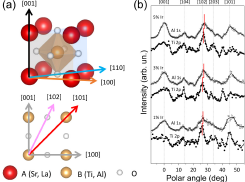Strain Relaxation at Doped Epitaxial Interfaces
Lippmaa Group
A quasi-two-dimensional quantum well is known to form by electron accumulation at an epitaxial heterointerface between SrTiO3 and LaAlO3. The accumulation of carriers at this interface is the result of a peculiar interplay between several effects, including the polar discontinuity between SrTiO3 and LaAlO3, tetragonal distortion of the interface layer due to the 3% epitaxial strain at the interface, field- and strain-dependent giant dielectric permittivity of SrTiO3, and possibly due to Sr and La intermixing within the first unit cell of the interface. Although the carrier number is essentially fixed by the structure, it is possible to tune the depth distribution of the accumulated carriers by either top- or bottom-side gating, thereby changing the occupancy of the nearly degenerate dxy, dxz, and dyz orbitals. Due to the tetragonal distortion of the interface layer, the orbital degeneracy is partially lifted, lowering the energy of the dxy orbital. Gating can then be used to shift the Fermi level below or above the level crossing, leaving the dxz/yz orbitals either empty or partly filled. One unique feature of this interface is the sharply asymmetric potential profile of the quantum well due to the wide bandgap of LaAlO3. This asymmetry leads to a relatively strong Rashba-type spin-orbit coupling at the interface and this coupling strength can be tuned to some extent by gating, either because the asymmetry of the potential well is changed or due to a Lifshitz transition that occurs when the Fermi level is tuned across the dxy – dxz,yz crossing.

Fig. 1. Crystal FFP orientations. (a) Schematic of sample orientation and the FFP directions in the (010) plane when the emitter is a B-site atom (Al or Ti). (b) XPD polar curves for Ir-doped samples comparing Al 1s and Ti 2p emission signals for different Ir doping levels.
Since this level crossing energy is determined by the tetragonal distortion of the interface layer, we have turned our attention to the possibility of tuning the interfacial strain by doping the interface. Additionally, by adding heavy elements, such as Ir to the interface, it may be possible to control the spin-orbit coupling experienced by the electrons in the quantum well.
SrTiO3/LaAlO3 heterostructures with interfaces doped either with Ir or Co were grown by pulsed laser deposition and the interfacial strain relaxation was studied by hard (7940 eV) x-ray photoelectron diffraction (XPD) at SPring-8 BL47XU. It was thus possible to estimate the strain state at the interface by comparing XPD forward focusing peak (FFP) positions between La and Sr (perovskite A-site) or Al and Ti (perovskite B-site) (Fig. 1) for different interface doping levels. A shift of the La and Al FFPs towards larger angles relative to Sr and Ti showed that in all cases the LaAlO3 cap layer is under compressive strain in the out-of-plane direction due to epitaxial strain. However, the level of strain depends on interface doping, especially for Ir. One possible cause is the interdiffusion of Ir across the SrTiO3/LaAlO3 interface. The work suggests that the interfacial strain can be tuned by doping the first unit cell layer of LaAlO3 at the interface with a larger ionic radius cation to reduce the epitaxial strain imposed on the first few unit cells of SrTiO3. This technique may be effective for controlling the critical carrier density where the Lifshitz transition occurs and thus selecting the gate bias range where the spin-orbit coupling in the quantum well is tunable by gating.
References
- [1] M. Lee, X. L. Tan, M. Yoneda, T. Okamoto, I. Tanaka, Y. Higa, D. Peng, M. Ogi, S. Kobayashi, M. Taguchi, M. Lippmaa, M.-J. Casanove, and H. Daimon, J. Phys. Soc. Jpn. 87, 084601 (2018).
